7HURM012W.2 - Employee Engagement and Organizational Performance
VerifiedAdded on 2023/06/18
|21
|4704
|254
Literature Review
AI Summary
This literature review explores the multifaceted concept of employee engagement and its impact on organizational performance. It begins by examining various definitions of employee engagement, highlighting its cognitive, emotional, and behavioral aspects. The review then discusses the relationship between employee engagement and organizational performance, noting that engaged employees contribute to improved operational efficiency, customer satisfaction, and overall business success. The paper also touches upon the role of workforce diversity and how it can influence the relationship between engagement and performance. The problem statement focuses on how employee engagement affects organizational performance, considering the potential influence of workforce diversity elements. The review concludes by presenting a conceptual framework and research hypothesis, aiming to determine the extent to which workforce diversity moderates the relationship between employee engagement and organizational performance. Desklib provides access to similar resources and solved assignments for students.
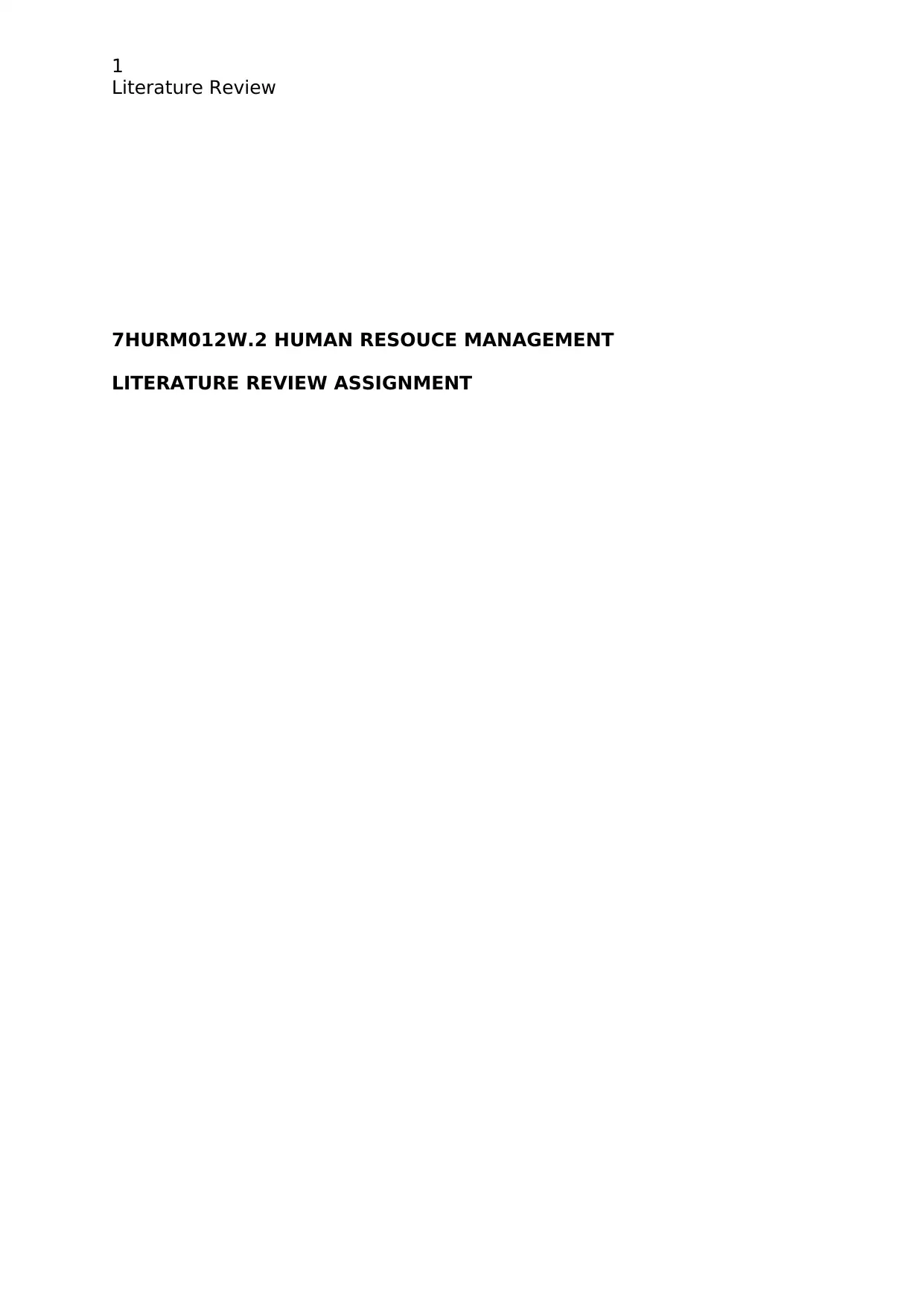
1
Literature Review
7HURM012W.2 HUMAN RESOUCE MANAGEMENT
LITERATURE REVIEW ASSIGNMENT
Literature Review
7HURM012W.2 HUMAN RESOUCE MANAGEMENT
LITERATURE REVIEW ASSIGNMENT
Paraphrase This Document
Need a fresh take? Get an instant paraphrase of this document with our AI Paraphraser
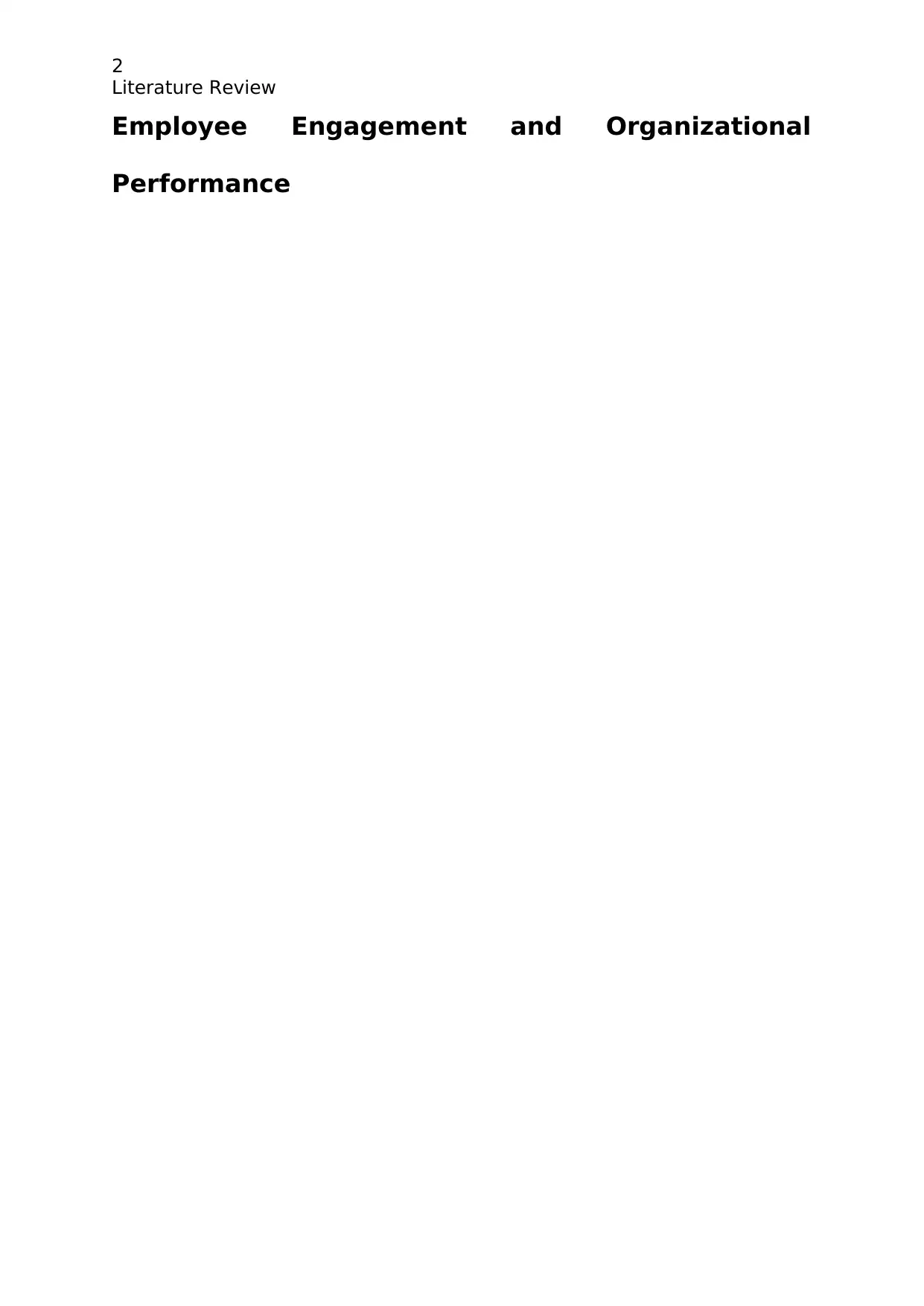
2
Literature Review
Employee Engagement and Organizational
Performance
Literature Review
Employee Engagement and Organizational
Performance
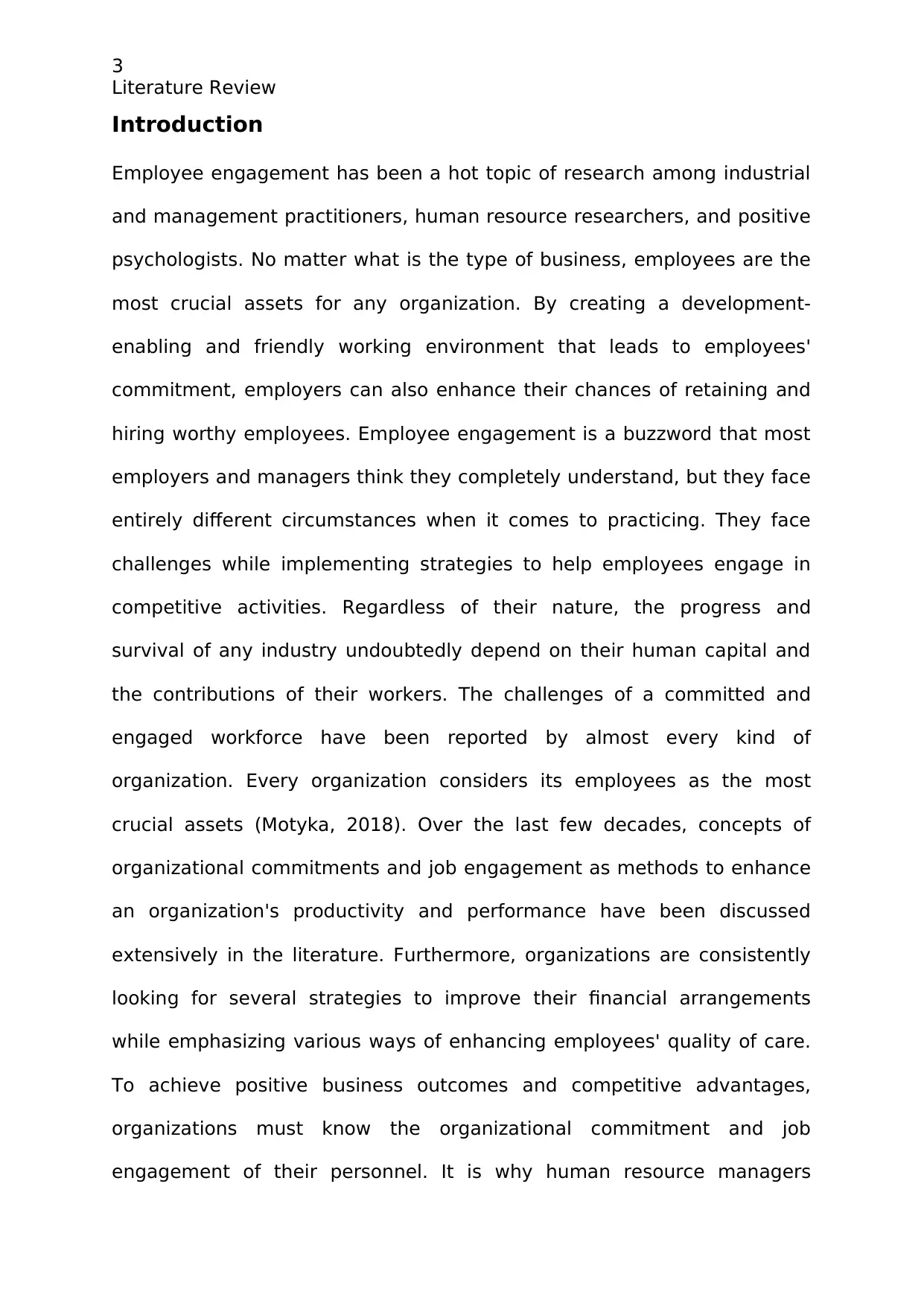
3
Literature Review
Introduction
Employee engagement has been a hot topic of research among industrial
and management practitioners, human resource researchers, and positive
psychologists. No matter what is the type of business, employees are the
most crucial assets for any organization. By creating a development-
enabling and friendly working environment that leads to employees'
commitment, employers can also enhance their chances of retaining and
hiring worthy employees. Employee engagement is a buzzword that most
employers and managers think they completely understand, but they face
entirely different circumstances when it comes to practicing. They face
challenges while implementing strategies to help employees engage in
competitive activities. Regardless of their nature, the progress and
survival of any industry undoubtedly depend on their human capital and
the contributions of their workers. The challenges of a committed and
engaged workforce have been reported by almost every kind of
organization. Every organization considers its employees as the most
crucial assets (Motyka, 2018). Over the last few decades, concepts of
organizational commitments and job engagement as methods to enhance
an organization's productivity and performance have been discussed
extensively in the literature. Furthermore, organizations are consistently
looking for several strategies to improve their financial arrangements
while emphasizing various ways of enhancing employees' quality of care.
To achieve positive business outcomes and competitive advantages,
organizations must know the organizational commitment and job
engagement of their personnel. It is why human resource managers
Literature Review
Introduction
Employee engagement has been a hot topic of research among industrial
and management practitioners, human resource researchers, and positive
psychologists. No matter what is the type of business, employees are the
most crucial assets for any organization. By creating a development-
enabling and friendly working environment that leads to employees'
commitment, employers can also enhance their chances of retaining and
hiring worthy employees. Employee engagement is a buzzword that most
employers and managers think they completely understand, but they face
entirely different circumstances when it comes to practicing. They face
challenges while implementing strategies to help employees engage in
competitive activities. Regardless of their nature, the progress and
survival of any industry undoubtedly depend on their human capital and
the contributions of their workers. The challenges of a committed and
engaged workforce have been reported by almost every kind of
organization. Every organization considers its employees as the most
crucial assets (Motyka, 2018). Over the last few decades, concepts of
organizational commitments and job engagement as methods to enhance
an organization's productivity and performance have been discussed
extensively in the literature. Furthermore, organizations are consistently
looking for several strategies to improve their financial arrangements
while emphasizing various ways of enhancing employees' quality of care.
To achieve positive business outcomes and competitive advantages,
organizations must know the organizational commitment and job
engagement of their personnel. It is why human resource managers
⊘ This is a preview!⊘
Do you want full access?
Subscribe today to unlock all pages.

Trusted by 1+ million students worldwide
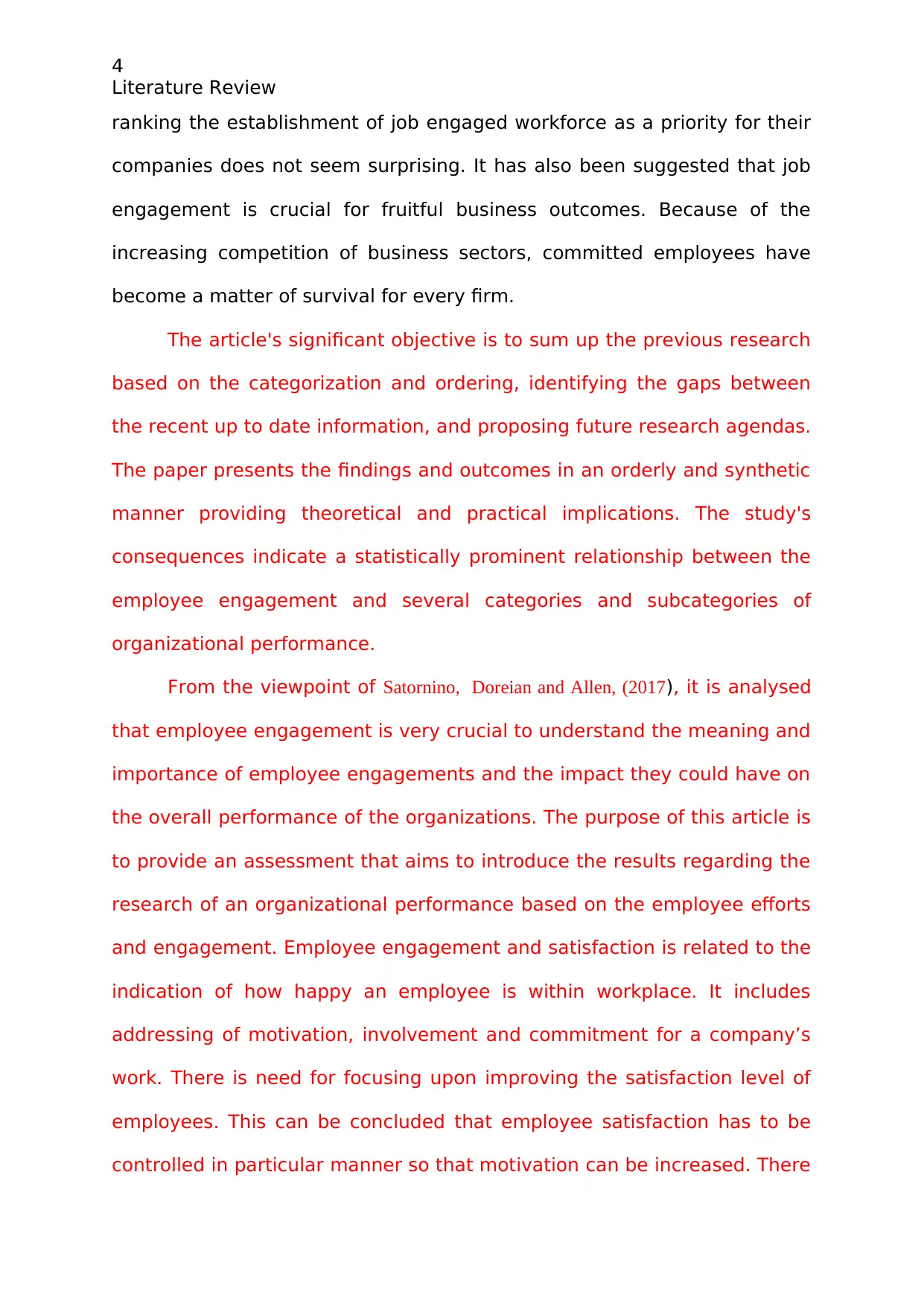
4
Literature Review
ranking the establishment of job engaged workforce as a priority for their
companies does not seem surprising. It has also been suggested that job
engagement is crucial for fruitful business outcomes. Because of the
increasing competition of business sectors, committed employees have
become a matter of survival for every firm.
The article's significant objective is to sum up the previous research
based on the categorization and ordering, identifying the gaps between
the recent up to date information, and proposing future research agendas.
The paper presents the findings and outcomes in an orderly and synthetic
manner providing theoretical and practical implications. The study's
consequences indicate a statistically prominent relationship between the
employee engagement and several categories and subcategories of
organizational performance.
From the viewpoint of Satornino, Doreian and Allen, (2017), it is analysed
that employee engagement is very crucial to understand the meaning and
importance of employee engagements and the impact they could have on
the overall performance of the organizations. The purpose of this article is
to provide an assessment that aims to introduce the results regarding the
research of an organizational performance based on the employee efforts
and engagement. Employee engagement and satisfaction is related to the
indication of how happy an employee is within workplace. It includes
addressing of motivation, involvement and commitment for a company’s
work. There is need for focusing upon improving the satisfaction level of
employees. This can be concluded that employee satisfaction has to be
controlled in particular manner so that motivation can be increased. There
Literature Review
ranking the establishment of job engaged workforce as a priority for their
companies does not seem surprising. It has also been suggested that job
engagement is crucial for fruitful business outcomes. Because of the
increasing competition of business sectors, committed employees have
become a matter of survival for every firm.
The article's significant objective is to sum up the previous research
based on the categorization and ordering, identifying the gaps between
the recent up to date information, and proposing future research agendas.
The paper presents the findings and outcomes in an orderly and synthetic
manner providing theoretical and practical implications. The study's
consequences indicate a statistically prominent relationship between the
employee engagement and several categories and subcategories of
organizational performance.
From the viewpoint of Satornino, Doreian and Allen, (2017), it is analysed
that employee engagement is very crucial to understand the meaning and
importance of employee engagements and the impact they could have on
the overall performance of the organizations. The purpose of this article is
to provide an assessment that aims to introduce the results regarding the
research of an organizational performance based on the employee efforts
and engagement. Employee engagement and satisfaction is related to the
indication of how happy an employee is within workplace. It includes
addressing of motivation, involvement and commitment for a company’s
work. There is need for focusing upon improving the satisfaction level of
employees. This can be concluded that employee satisfaction has to be
controlled in particular manner so that motivation can be increased. There
Paraphrase This Document
Need a fresh take? Get an instant paraphrase of this document with our AI Paraphraser
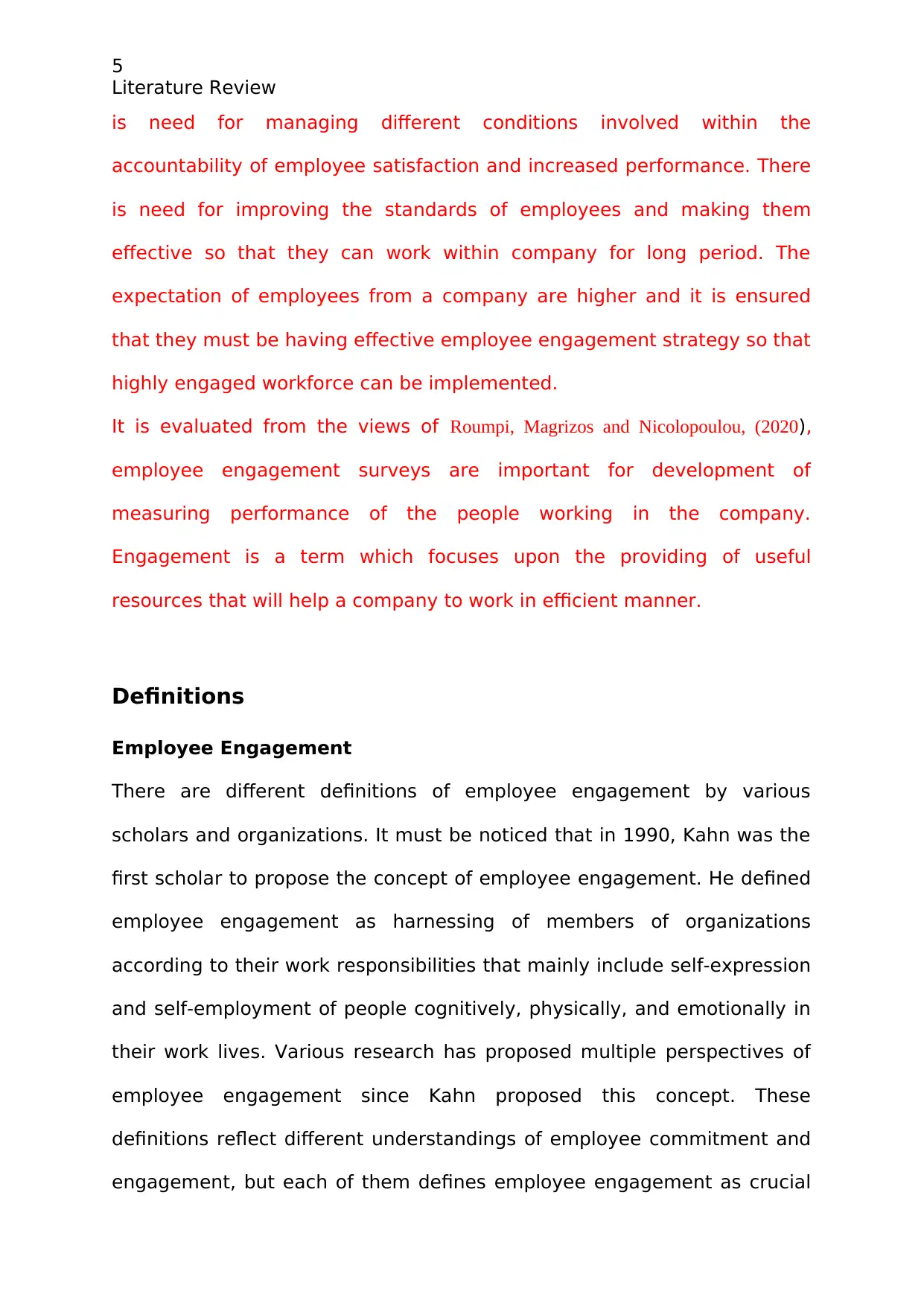
5
Literature Review
is need for managing different conditions involved within the
accountability of employee satisfaction and increased performance. There
is need for improving the standards of employees and making them
effective so that they can work within company for long period. The
expectation of employees from a company are higher and it is ensured
that they must be having effective employee engagement strategy so that
highly engaged workforce can be implemented.
It is evaluated from the views of Roumpi, Magrizos and Nicolopoulou, (2020),
employee engagement surveys are important for development of
measuring performance of the people working in the company.
Engagement is a term which focuses upon the providing of useful
resources that will help a company to work in efficient manner.
Definitions
Employee Engagement
There are different definitions of employee engagement by various
scholars and organizations. It must be noticed that in 1990, Kahn was the
first scholar to propose the concept of employee engagement. He defined
employee engagement as harnessing of members of organizations
according to their work responsibilities that mainly include self-expression
and self-employment of people cognitively, physically, and emotionally in
their work lives. Various research has proposed multiple perspectives of
employee engagement since Kahn proposed this concept. These
definitions reflect different understandings of employee commitment and
engagement, but each of them defines employee engagement as crucial
Literature Review
is need for managing different conditions involved within the
accountability of employee satisfaction and increased performance. There
is need for improving the standards of employees and making them
effective so that they can work within company for long period. The
expectation of employees from a company are higher and it is ensured
that they must be having effective employee engagement strategy so that
highly engaged workforce can be implemented.
It is evaluated from the views of Roumpi, Magrizos and Nicolopoulou, (2020),
employee engagement surveys are important for development of
measuring performance of the people working in the company.
Engagement is a term which focuses upon the providing of useful
resources that will help a company to work in efficient manner.
Definitions
Employee Engagement
There are different definitions of employee engagement by various
scholars and organizations. It must be noticed that in 1990, Kahn was the
first scholar to propose the concept of employee engagement. He defined
employee engagement as harnessing of members of organizations
according to their work responsibilities that mainly include self-expression
and self-employment of people cognitively, physically, and emotionally in
their work lives. Various research has proposed multiple perspectives of
employee engagement since Kahn proposed this concept. These
definitions reflect different understandings of employee commitment and
engagement, but each of them defines employee engagement as crucial
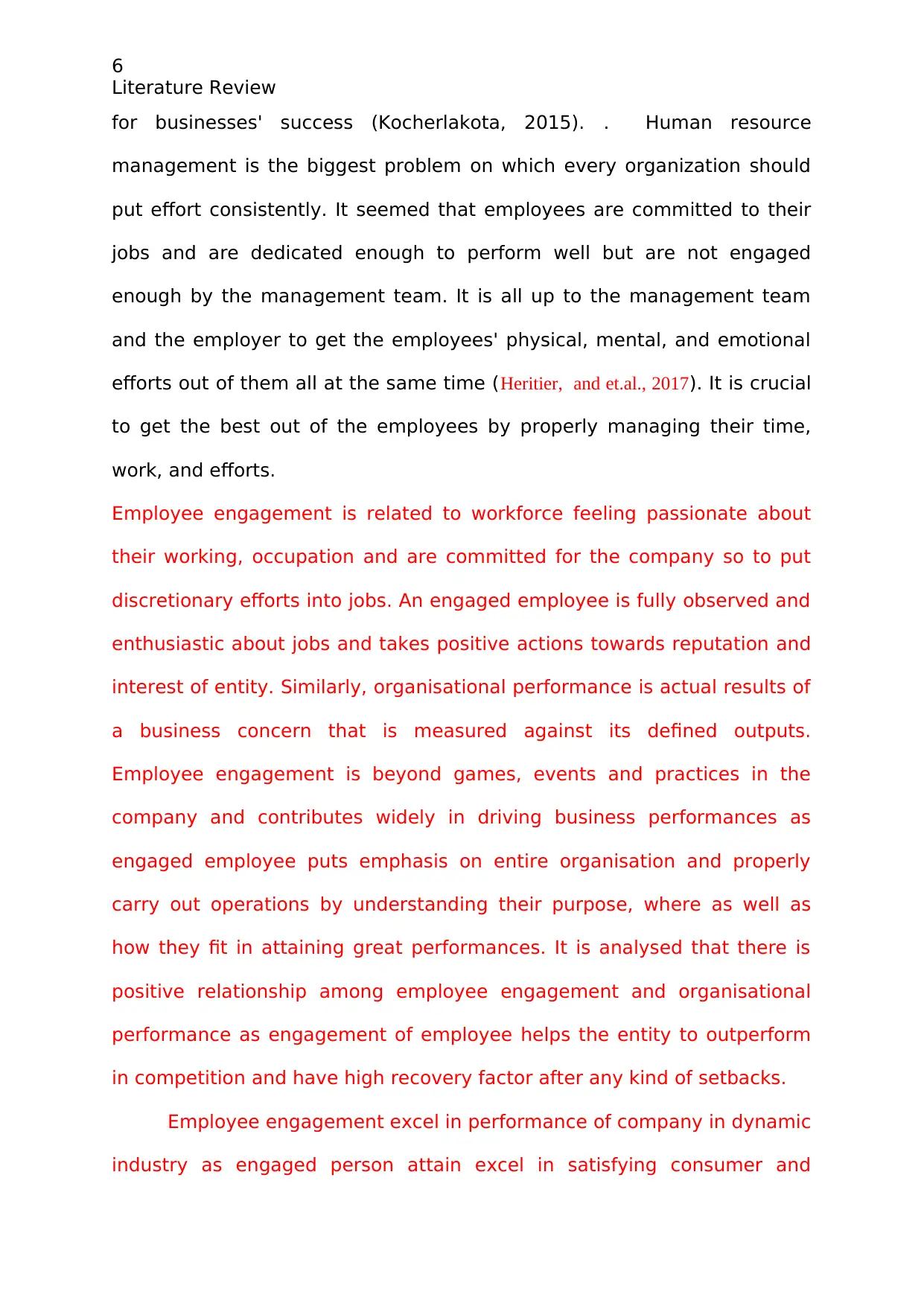
6
Literature Review
for businesses' success (Kocherlakota, 2015). . Human resource
management is the biggest problem on which every organization should
put effort consistently. It seemed that employees are committed to their
jobs and are dedicated enough to perform well but are not engaged
enough by the management team. It is all up to the management team
and the employer to get the employees' physical, mental, and emotional
efforts out of them all at the same time (Heritier, and et.al., 2017). It is crucial
to get the best out of the employees by properly managing their time,
work, and efforts.
Employee engagement is related to workforce feeling passionate about
their working, occupation and are committed for the company so to put
discretionary efforts into jobs. An engaged employee is fully observed and
enthusiastic about jobs and takes positive actions towards reputation and
interest of entity. Similarly, organisational performance is actual results of
a business concern that is measured against its defined outputs.
Employee engagement is beyond games, events and practices in the
company and contributes widely in driving business performances as
engaged employee puts emphasis on entire organisation and properly
carry out operations by understanding their purpose, where as well as
how they fit in attaining great performances. It is analysed that there is
positive relationship among employee engagement and organisational
performance as engagement of employee helps the entity to outperform
in competition and have high recovery factor after any kind of setbacks.
Employee engagement excel in performance of company in dynamic
industry as engaged person attain excel in satisfying consumer and
Literature Review
for businesses' success (Kocherlakota, 2015). . Human resource
management is the biggest problem on which every organization should
put effort consistently. It seemed that employees are committed to their
jobs and are dedicated enough to perform well but are not engaged
enough by the management team. It is all up to the management team
and the employer to get the employees' physical, mental, and emotional
efforts out of them all at the same time (Heritier, and et.al., 2017). It is crucial
to get the best out of the employees by properly managing their time,
work, and efforts.
Employee engagement is related to workforce feeling passionate about
their working, occupation and are committed for the company so to put
discretionary efforts into jobs. An engaged employee is fully observed and
enthusiastic about jobs and takes positive actions towards reputation and
interest of entity. Similarly, organisational performance is actual results of
a business concern that is measured against its defined outputs.
Employee engagement is beyond games, events and practices in the
company and contributes widely in driving business performances as
engaged employee puts emphasis on entire organisation and properly
carry out operations by understanding their purpose, where as well as
how they fit in attaining great performances. It is analysed that there is
positive relationship among employee engagement and organisational
performance as engagement of employee helps the entity to outperform
in competition and have high recovery factor after any kind of setbacks.
Employee engagement excel in performance of company in dynamic
industry as engaged person attain excel in satisfying consumer and
⊘ This is a preview!⊘
Do you want full access?
Subscribe today to unlock all pages.

Trusted by 1+ million students worldwide
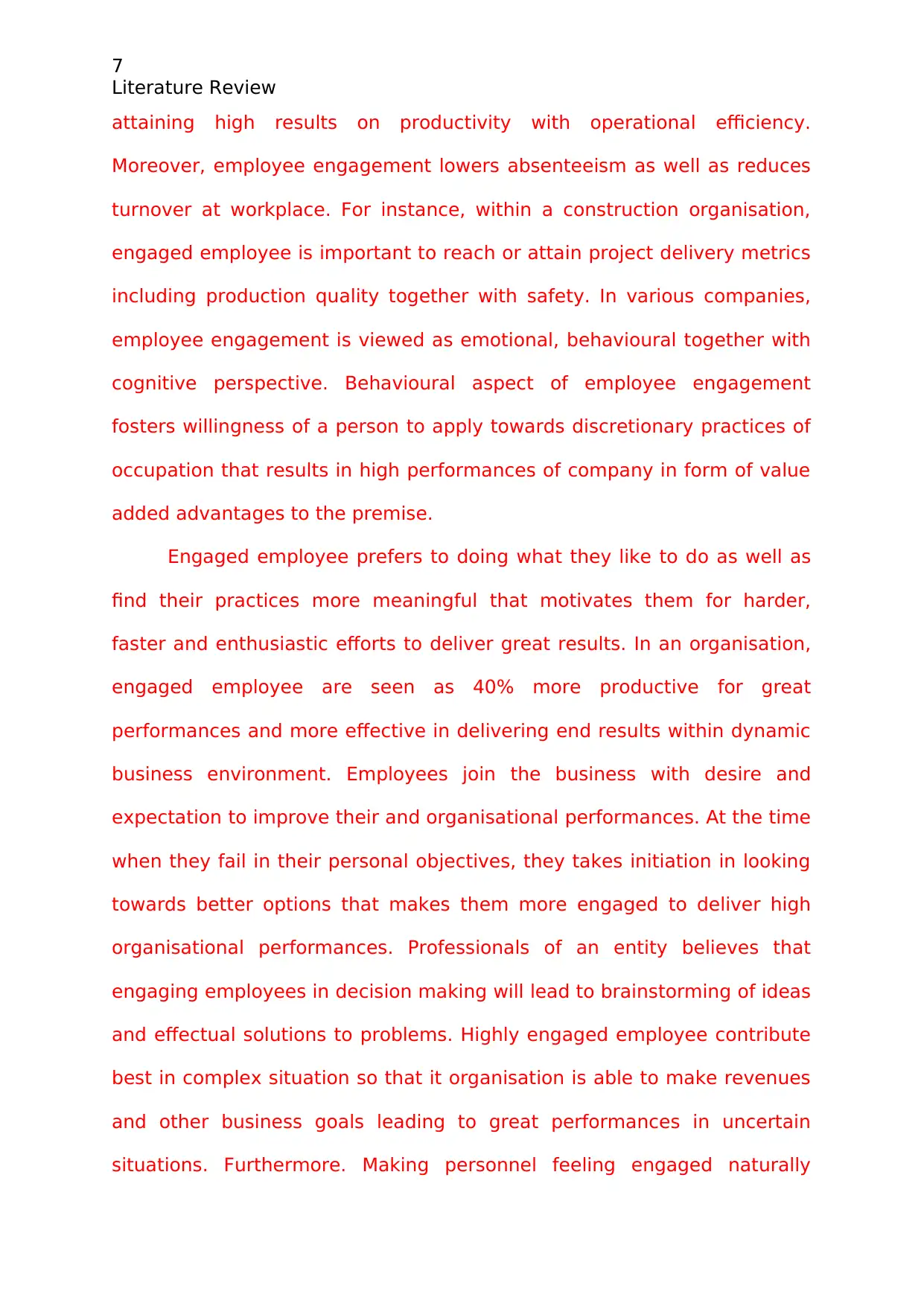
7
Literature Review
attaining high results on productivity with operational efficiency.
Moreover, employee engagement lowers absenteeism as well as reduces
turnover at workplace. For instance, within a construction organisation,
engaged employee is important to reach or attain project delivery metrics
including production quality together with safety. In various companies,
employee engagement is viewed as emotional, behavioural together with
cognitive perspective. Behavioural aspect of employee engagement
fosters willingness of a person to apply towards discretionary practices of
occupation that results in high performances of company in form of value
added advantages to the premise.
Engaged employee prefers to doing what they like to do as well as
find their practices more meaningful that motivates them for harder,
faster and enthusiastic efforts to deliver great results. In an organisation,
engaged employee are seen as 40% more productive for great
performances and more effective in delivering end results within dynamic
business environment. Employees join the business with desire and
expectation to improve their and organisational performances. At the time
when they fail in their personal objectives, they takes initiation in looking
towards better options that makes them more engaged to deliver high
organisational performances. Professionals of an entity believes that
engaging employees in decision making will lead to brainstorming of ideas
and effectual solutions to problems. Highly engaged employee contribute
best in complex situation so that it organisation is able to make revenues
and other business goals leading to great performances in uncertain
situations. Furthermore. Making personnel feeling engaged naturally
Literature Review
attaining high results on productivity with operational efficiency.
Moreover, employee engagement lowers absenteeism as well as reduces
turnover at workplace. For instance, within a construction organisation,
engaged employee is important to reach or attain project delivery metrics
including production quality together with safety. In various companies,
employee engagement is viewed as emotional, behavioural together with
cognitive perspective. Behavioural aspect of employee engagement
fosters willingness of a person to apply towards discretionary practices of
occupation that results in high performances of company in form of value
added advantages to the premise.
Engaged employee prefers to doing what they like to do as well as
find their practices more meaningful that motivates them for harder,
faster and enthusiastic efforts to deliver great results. In an organisation,
engaged employee are seen as 40% more productive for great
performances and more effective in delivering end results within dynamic
business environment. Employees join the business with desire and
expectation to improve their and organisational performances. At the time
when they fail in their personal objectives, they takes initiation in looking
towards better options that makes them more engaged to deliver high
organisational performances. Professionals of an entity believes that
engaging employees in decision making will lead to brainstorming of ideas
and effectual solutions to problems. Highly engaged employee contribute
best in complex situation so that it organisation is able to make revenues
and other business goals leading to great performances in uncertain
situations. Furthermore. Making personnel feeling engaged naturally
Paraphrase This Document
Need a fresh take? Get an instant paraphrase of this document with our AI Paraphraser
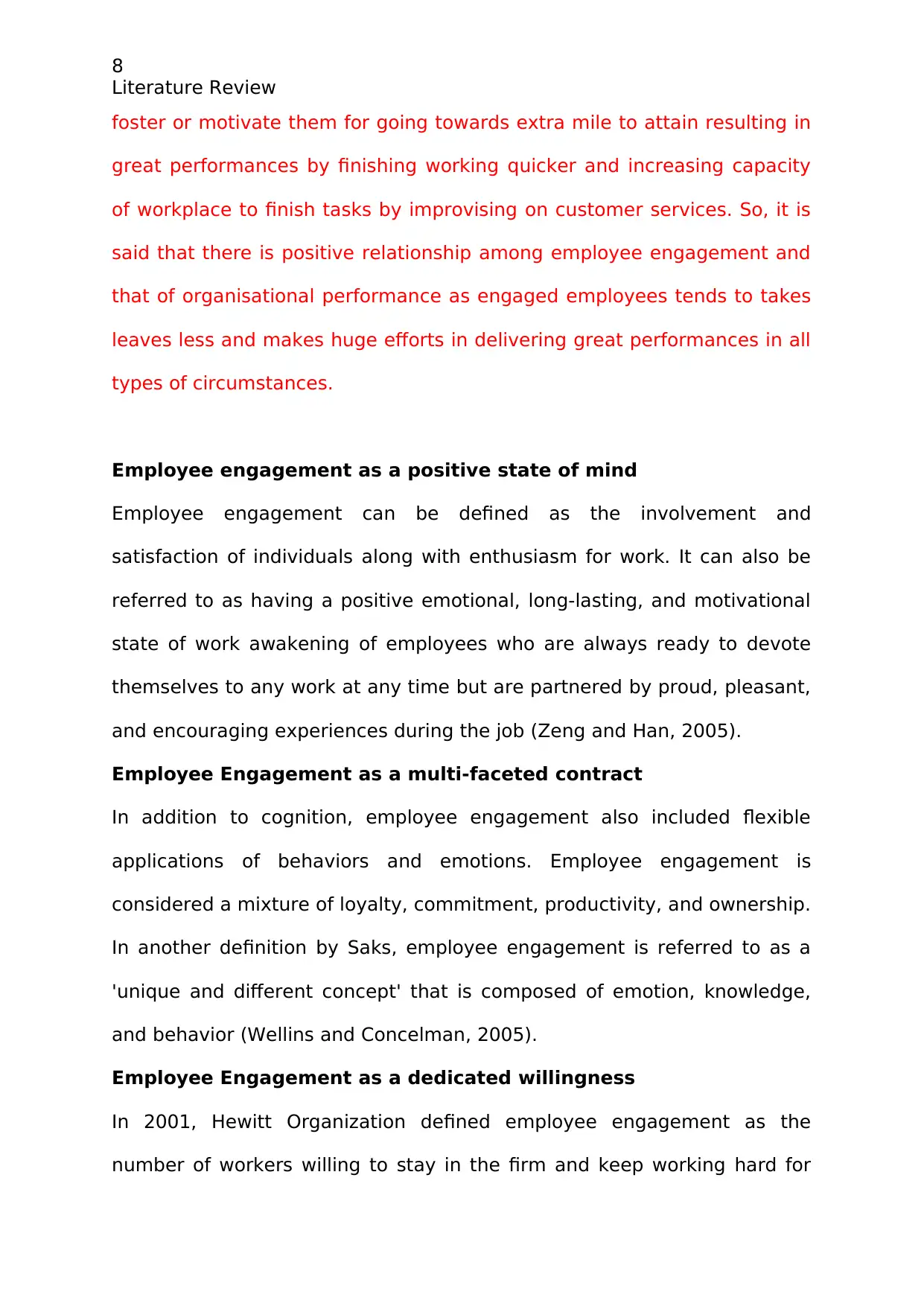
8
Literature Review
foster or motivate them for going towards extra mile to attain resulting in
great performances by finishing working quicker and increasing capacity
of workplace to finish tasks by improvising on customer services. So, it is
said that there is positive relationship among employee engagement and
that of organisational performance as engaged employees tends to takes
leaves less and makes huge efforts in delivering great performances in all
types of circumstances.
Employee engagement as a positive state of mind
Employee engagement can be defined as the involvement and
satisfaction of individuals along with enthusiasm for work. It can also be
referred to as having a positive emotional, long-lasting, and motivational
state of work awakening of employees who are always ready to devote
themselves to any work at any time but are partnered by proud, pleasant,
and encouraging experiences during the job (Zeng and Han, 2005).
Employee Engagement as a multi-faceted contract
In addition to cognition, employee engagement also included flexible
applications of behaviors and emotions. Employee engagement is
considered a mixture of loyalty, commitment, productivity, and ownership.
In another definition by Saks, employee engagement is referred to as a
'unique and different concept' that is composed of emotion, knowledge,
and behavior (Wellins and Concelman, 2005).
Employee Engagement as a dedicated willingness
In 2001, Hewitt Organization defined employee engagement as the
number of workers willing to stay in the firm and keep working hard for
Literature Review
foster or motivate them for going towards extra mile to attain resulting in
great performances by finishing working quicker and increasing capacity
of workplace to finish tasks by improvising on customer services. So, it is
said that there is positive relationship among employee engagement and
that of organisational performance as engaged employees tends to takes
leaves less and makes huge efforts in delivering great performances in all
types of circumstances.
Employee engagement as a positive state of mind
Employee engagement can be defined as the involvement and
satisfaction of individuals along with enthusiasm for work. It can also be
referred to as having a positive emotional, long-lasting, and motivational
state of work awakening of employees who are always ready to devote
themselves to any work at any time but are partnered by proud, pleasant,
and encouraging experiences during the job (Zeng and Han, 2005).
Employee Engagement as a multi-faceted contract
In addition to cognition, employee engagement also included flexible
applications of behaviors and emotions. Employee engagement is
considered a mixture of loyalty, commitment, productivity, and ownership.
In another definition by Saks, employee engagement is referred to as a
'unique and different concept' that is composed of emotion, knowledge,
and behavior (Wellins and Concelman, 2005).
Employee Engagement as a dedicated willingness
In 2001, Hewitt Organization defined employee engagement as the
number of workers willing to stay in the firm and keep working hard for
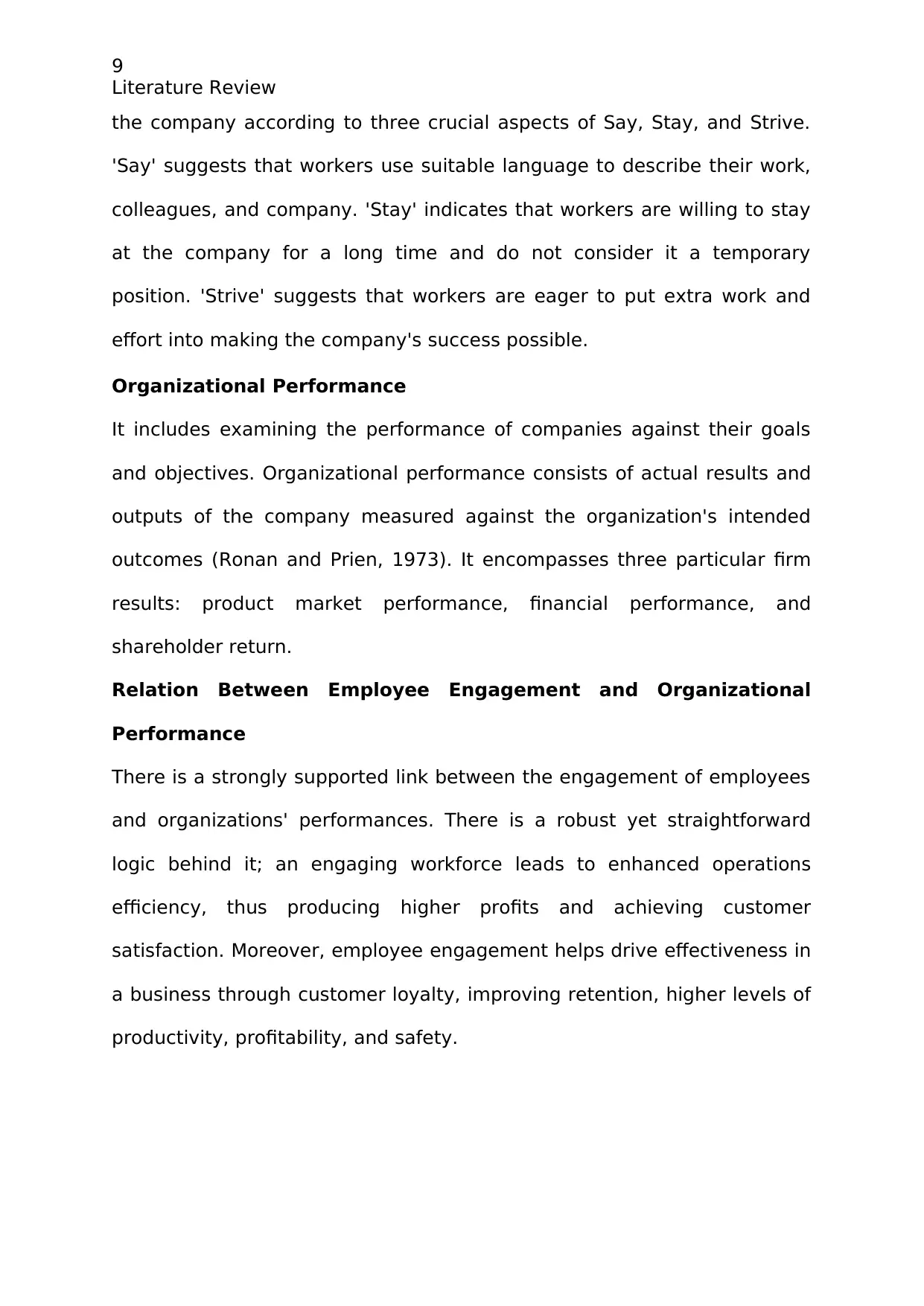
9
Literature Review
the company according to three crucial aspects of Say, Stay, and Strive.
'Say' suggests that workers use suitable language to describe their work,
colleagues, and company. 'Stay' indicates that workers are willing to stay
at the company for a long time and do not consider it a temporary
position. 'Strive' suggests that workers are eager to put extra work and
effort into making the company's success possible.
Organizational Performance
It includes examining the performance of companies against their goals
and objectives. Organizational performance consists of actual results and
outputs of the company measured against the organization's intended
outcomes (Ronan and Prien, 1973). It encompasses three particular firm
results: product market performance, financial performance, and
shareholder return.
Relation Between Employee Engagement and Organizational
Performance
There is a strongly supported link between the engagement of employees
and organizations' performances. There is a robust yet straightforward
logic behind it; an engaging workforce leads to enhanced operations
efficiency, thus producing higher profits and achieving customer
satisfaction. Moreover, employee engagement helps drive effectiveness in
a business through customer loyalty, improving retention, higher levels of
productivity, profitability, and safety.
Literature Review
the company according to three crucial aspects of Say, Stay, and Strive.
'Say' suggests that workers use suitable language to describe their work,
colleagues, and company. 'Stay' indicates that workers are willing to stay
at the company for a long time and do not consider it a temporary
position. 'Strive' suggests that workers are eager to put extra work and
effort into making the company's success possible.
Organizational Performance
It includes examining the performance of companies against their goals
and objectives. Organizational performance consists of actual results and
outputs of the company measured against the organization's intended
outcomes (Ronan and Prien, 1973). It encompasses three particular firm
results: product market performance, financial performance, and
shareholder return.
Relation Between Employee Engagement and Organizational
Performance
There is a strongly supported link between the engagement of employees
and organizations' performances. There is a robust yet straightforward
logic behind it; an engaging workforce leads to enhanced operations
efficiency, thus producing higher profits and achieving customer
satisfaction. Moreover, employee engagement helps drive effectiveness in
a business through customer loyalty, improving retention, higher levels of
productivity, profitability, and safety.
⊘ This is a preview!⊘
Do you want full access?
Subscribe today to unlock all pages.

Trusted by 1+ million students worldwide
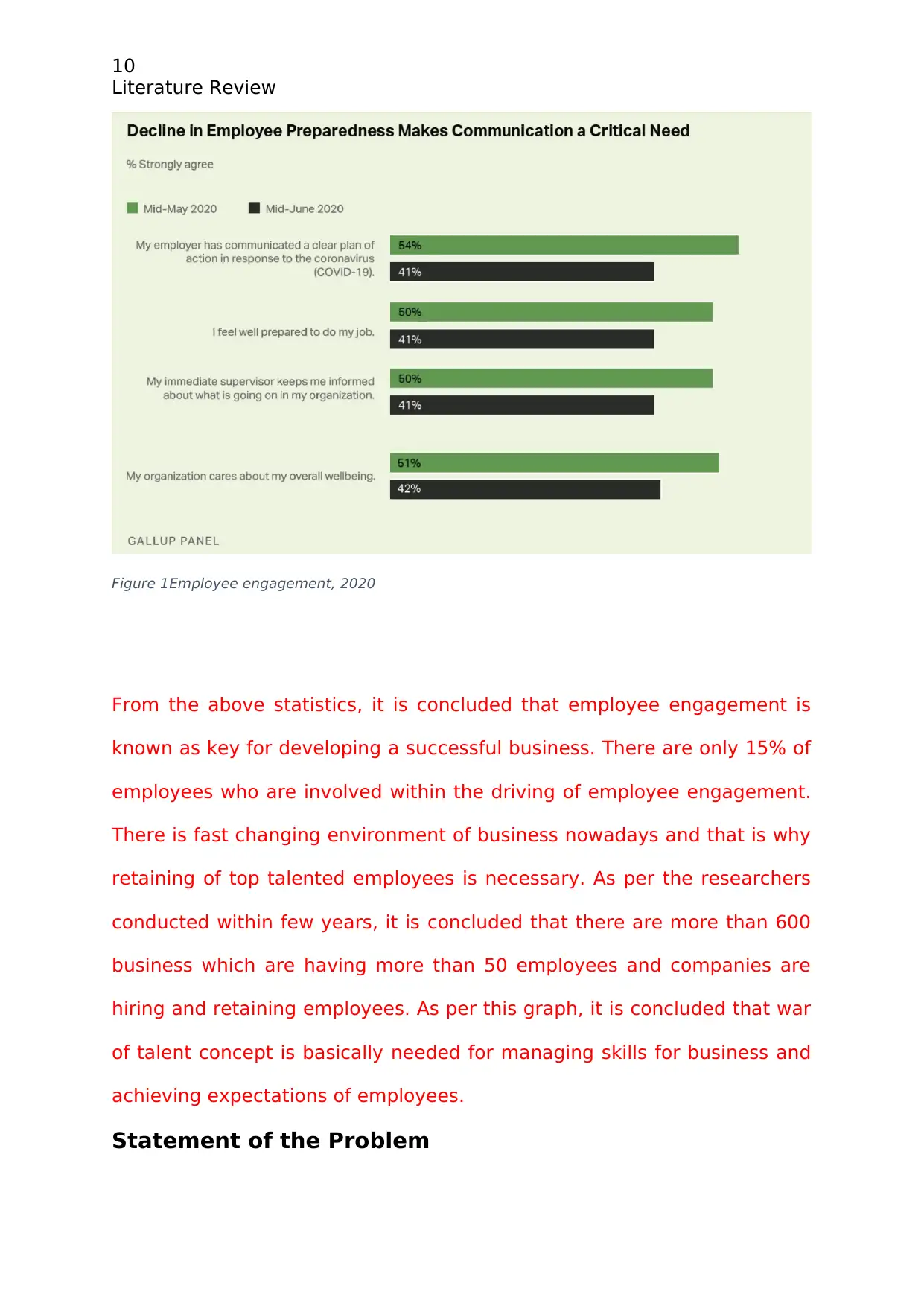
10
Literature Review
Figure 1Employee engagement, 2020
From the above statistics, it is concluded that employee engagement is
known as key for developing a successful business. There are only 15% of
employees who are involved within the driving of employee engagement.
There is fast changing environment of business nowadays and that is why
retaining of top talented employees is necessary. As per the researchers
conducted within few years, it is concluded that there are more than 600
business which are having more than 50 employees and companies are
hiring and retaining employees. As per this graph, it is concluded that war
of talent concept is basically needed for managing skills for business and
achieving expectations of employees.
Statement of the Problem
Literature Review
Figure 1Employee engagement, 2020
From the above statistics, it is concluded that employee engagement is
known as key for developing a successful business. There are only 15% of
employees who are involved within the driving of employee engagement.
There is fast changing environment of business nowadays and that is why
retaining of top talented employees is necessary. As per the researchers
conducted within few years, it is concluded that there are more than 600
business which are having more than 50 employees and companies are
hiring and retaining employees. As per this graph, it is concluded that war
of talent concept is basically needed for managing skills for business and
achieving expectations of employees.
Statement of the Problem
Paraphrase This Document
Need a fresh take? Get an instant paraphrase of this document with our AI Paraphraser
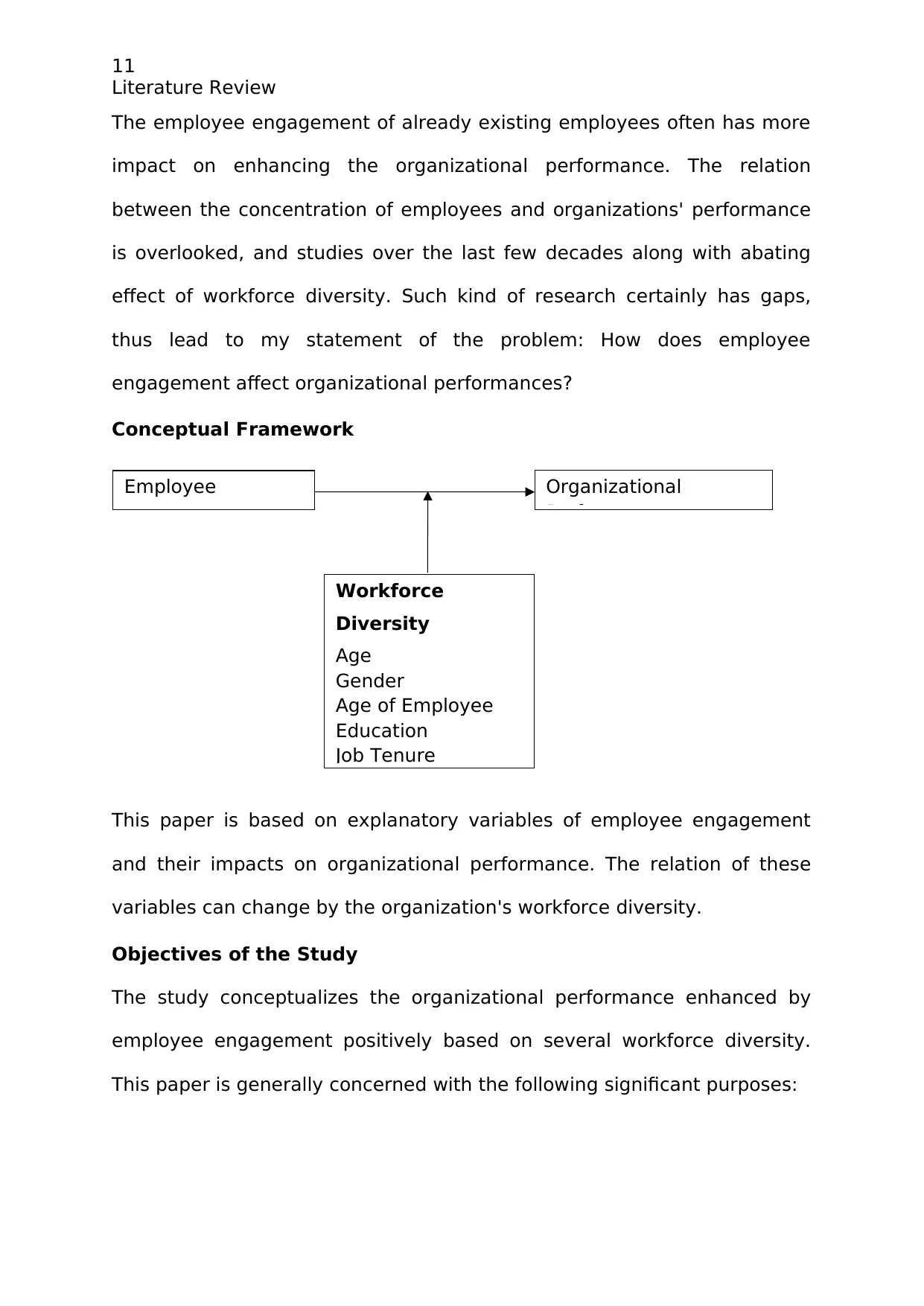
11
Literature Review
The employee engagement of already existing employees often has more
impact on enhancing the organizational performance. The relation
between the concentration of employees and organizations' performance
is overlooked, and studies over the last few decades along with abating
effect of workforce diversity. Such kind of research certainly has gaps,
thus lead to my statement of the problem: How does employee
engagement affect organizational performances?
Conceptual Framework
This paper is based on explanatory variables of employee engagement
and their impacts on organizational performance. The relation of these
variables can change by the organization's workforce diversity.
Objectives of the Study
The study conceptualizes the organizational performance enhanced by
employee engagement positively based on several workforce diversity.
This paper is generally concerned with the following significant purposes:
Employee
Engagement
Workforce
Diversity
Age
Gender
Age of Employee
Education
Job Tenure
Organizational
Performance
Literature Review
The employee engagement of already existing employees often has more
impact on enhancing the organizational performance. The relation
between the concentration of employees and organizations' performance
is overlooked, and studies over the last few decades along with abating
effect of workforce diversity. Such kind of research certainly has gaps,
thus lead to my statement of the problem: How does employee
engagement affect organizational performances?
Conceptual Framework
This paper is based on explanatory variables of employee engagement
and their impacts on organizational performance. The relation of these
variables can change by the organization's workforce diversity.
Objectives of the Study
The study conceptualizes the organizational performance enhanced by
employee engagement positively based on several workforce diversity.
This paper is generally concerned with the following significant purposes:
Employee
Engagement
Workforce
Diversity
Age
Gender
Age of Employee
Education
Job Tenure
Organizational
Performance
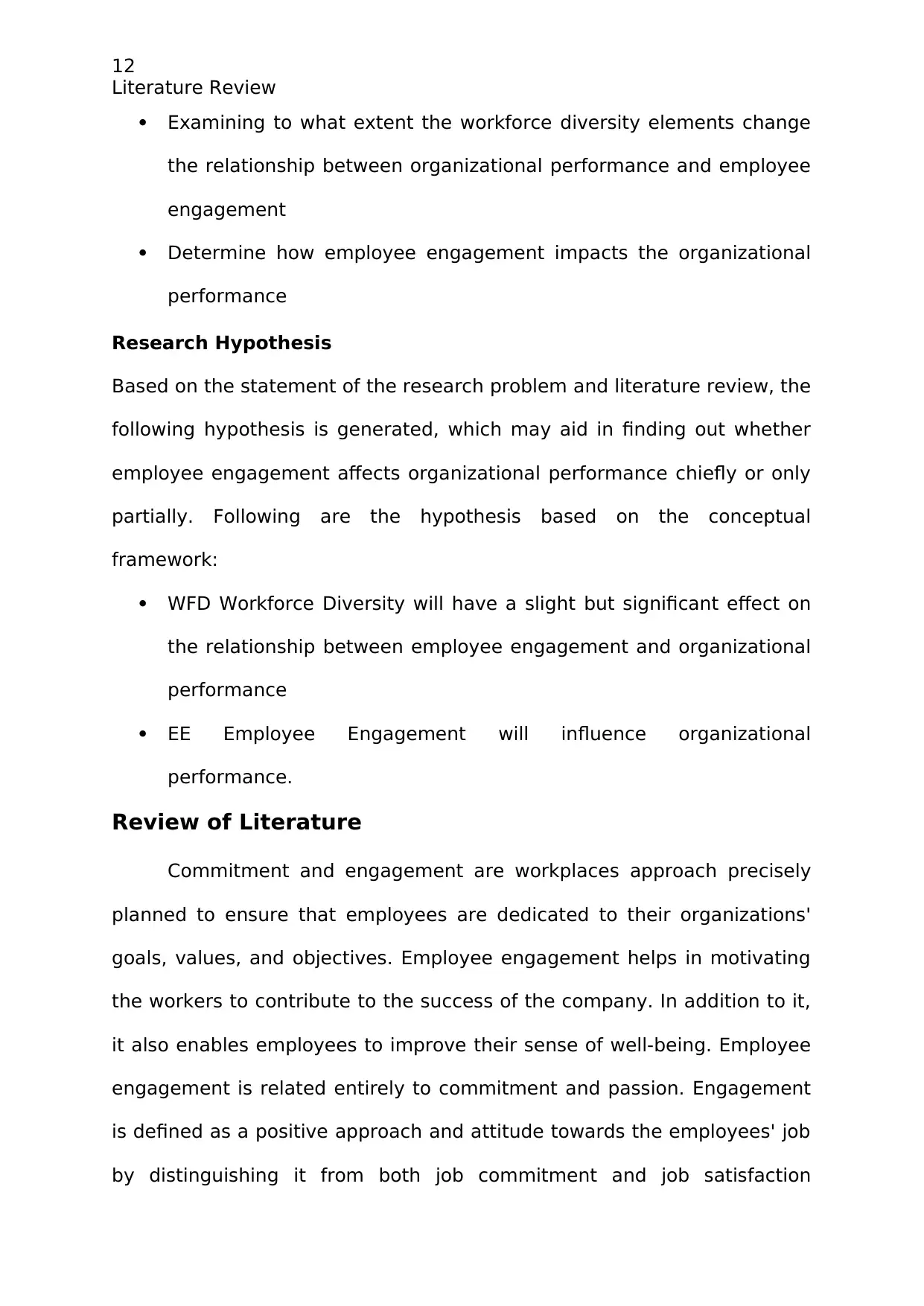
12
Literature Review
Examining to what extent the workforce diversity elements change
the relationship between organizational performance and employee
engagement
Determine how employee engagement impacts the organizational
performance
Research Hypothesis
Based on the statement of the research problem and literature review, the
following hypothesis is generated, which may aid in finding out whether
employee engagement affects organizational performance chiefly or only
partially. Following are the hypothesis based on the conceptual
framework:
WFD Workforce Diversity will have a slight but significant effect on
the relationship between employee engagement and organizational
performance
EE Employee Engagement will influence organizational
performance.
Review of Literature
Commitment and engagement are workplaces approach precisely
planned to ensure that employees are dedicated to their organizations'
goals, values, and objectives. Employee engagement helps in motivating
the workers to contribute to the success of the company. In addition to it,
it also enables employees to improve their sense of well-being. Employee
engagement is related entirely to commitment and passion. Engagement
is defined as a positive approach and attitude towards the employees' job
by distinguishing it from both job commitment and job satisfaction
Literature Review
Examining to what extent the workforce diversity elements change
the relationship between organizational performance and employee
engagement
Determine how employee engagement impacts the organizational
performance
Research Hypothesis
Based on the statement of the research problem and literature review, the
following hypothesis is generated, which may aid in finding out whether
employee engagement affects organizational performance chiefly or only
partially. Following are the hypothesis based on the conceptual
framework:
WFD Workforce Diversity will have a slight but significant effect on
the relationship between employee engagement and organizational
performance
EE Employee Engagement will influence organizational
performance.
Review of Literature
Commitment and engagement are workplaces approach precisely
planned to ensure that employees are dedicated to their organizations'
goals, values, and objectives. Employee engagement helps in motivating
the workers to contribute to the success of the company. In addition to it,
it also enables employees to improve their sense of well-being. Employee
engagement is related entirely to commitment and passion. Engagement
is defined as a positive approach and attitude towards the employees' job
by distinguishing it from both job commitment and job satisfaction
⊘ This is a preview!⊘
Do you want full access?
Subscribe today to unlock all pages.

Trusted by 1+ million students worldwide
1 out of 21
Related Documents
Your All-in-One AI-Powered Toolkit for Academic Success.
+13062052269
info@desklib.com
Available 24*7 on WhatsApp / Email
![[object Object]](/_next/static/media/star-bottom.7253800d.svg)
Unlock your academic potential
Copyright © 2020–2025 A2Z Services. All Rights Reserved. Developed and managed by ZUCOL.



